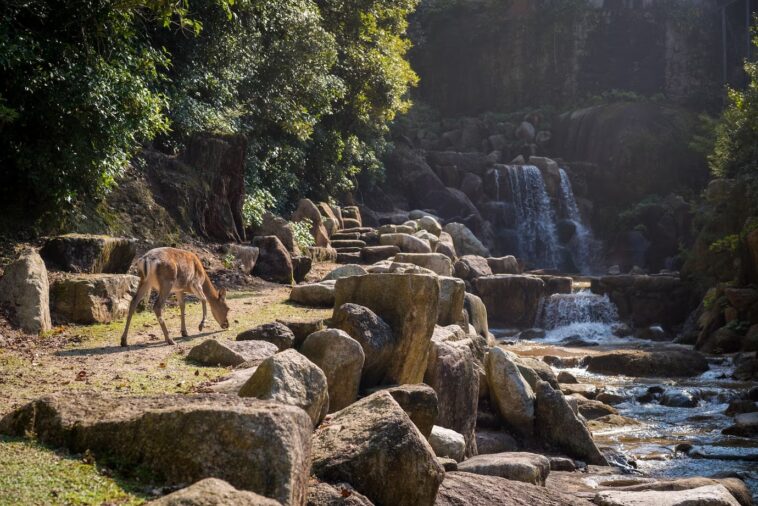Introduction
G’day, mates! If you’ve ever been enchanted by the captivating stories of Australia’s unique wildlife, you’re in for a treat today. With a cast of characters as diverse as kangaroos, koalas, wombats, and emus, the land Down Under presents an extraordinary array of endemic fauna that is as intriguing as it is diverse.
From the eucalyptus forests harbouring cuddly koalas to the rugged outback where kangaroos reign supreme, each Australian creature’s story is as unique as its landscape. So grab a cuppa, settle down comfortably, and let’s embark on an exciting adventure into the world of Australia’s incredible wildlife!
Kangaroos: The Iconic Symbols of Australia
To kick things off, let’s talk about kangaroos, probably the most iconic representative of Australia’s wildlife. These fascinating marsupials are known for their powerful hind legs and large, muscular tails that provide balance while hopping. In Australia, kangaroos aren’t just confined to zoos or wildlife parks, they freely roam the country’s vast landscapes, from the arid plains of the outback to the verdant coastal heathlands.
There are four different kangaroo species, each boasting its own distinct characteristics. However, one common and rather delightful trait is their maternal nature. Joeys, or baby kangaroos, spend their first few months cocooned in their mother’s pouch, an impressive example of motherhood in the animal kingdom.
Despite being a beloved national symbol, kangaroos face numerous threats. Habitat loss, climate change, and vehicle collisions pose significant risks. The Australian government and various wildlife organisations are working tirelessly on conservation efforts to maintain a healthy kangaroo population, such as implementing controls on land clearing and running awareness campaigns on responsible driving in kangaroo-prone areas.
Koalas: The Sleepy Treasures of the Eucalyptus Forests
From one marsupial to another, let’s turn our attention to the delightful koalas. Often mistaken for bears, these sleepy critters are marsupials like kangaroos. They are fussy eaters with a strong preference for a select few varieties of eucalyptus leaves.
Koalas are known for their slow-paced life, sleeping up to 20 hours a day! When they’re not snoozing, you’ll likely find them munching on eucalyptus leaves, their primary food source. It’s this diet that enables them to thrive in Australia’s eucalypt forests.
Unfortunately, koalas are under significant threat. The destruction of their habitat due to land development, bushfires, and climate change are contributing to a drastic decline in their numbers. Conservation groups are taking various measures such as rehabilitating injured koalas, planting new eucalyptus trees, and preserving existing habitats to protect these endearing animals.
Wombats: The Burrowers of the Bush
Wombats are another group of marsupials that grace the Australian bush with their presence. These stout, robust creatures are known for their burrowing habits, creating intricate tunnels in the ground with their strong legs and sharp claws.
A particularly interesting fact about wombats is their cube-shaped poo, a unique feature in the animal kingdom. It is believed that this peculiar shape prevents their droppings from rolling away, marking their territory and leading them back to their burrows.
Like their marsupial cousins, wombats face several threats. They are often victims of road accidents, and their habitat is increasingly encroached upon by human activities. Efforts to protect wombats include constructing wildlife corridors and tunnels under roads to prevent accidents and preserving their habitats from further destruction.
Emus: The Graceful Giants of the Grasslands
Last, but by no means least, we delve into the world of emus, Australia’s tallest native bird species. These large, flightless birds can reach up to 1.9 meters tall and are known for their impressive sprinting ability, reaching speeds of up to 50 km/h!
Emus are incredibly adaptable and can survive in diverse habitats, from the arid outback to coastal regions. They’re omnivorous, with a diet that includes seeds, fruits, insects, and small vertebrates.
Like the other animals we’ve explored, emus face their own set of challenges. They are often affected by drought and habitat loss, though they have proven to be resilient. Conservation measures include creating protected areas and managing resources to ensure that emus and other wildlife have access to food and water, especially during periods of drought.
Conclusion
Australia’s wildlife is a remarkable ensemble of unique creatures, each with its own fascinating habits, habitats, and challenges. While it’s easy to get lost in the charm of these animals, it’s also critical to remember the pressing threats they face and the tireless conservation efforts being made to protect them.
As we continue to navigate our relationship with the natural world, let’s carry a piece of Australia’s wildlife story in our hearts. It serves as a potent reminder that each creature, no matter how small or big, plays an irreplaceable role in the grand tapestry of life.
Whether it’s the bounding kangaroo, the sleepy koala, the burrowing wombat, or the towering emu, Australia’s unique wildlife is an incredible testament to the wonder of our planet’s biodiversity. Let’s cherish it, protect it, and allow future generations to be captivated by their own encounters with these incredible Aussie animals.




Comments
0 comments